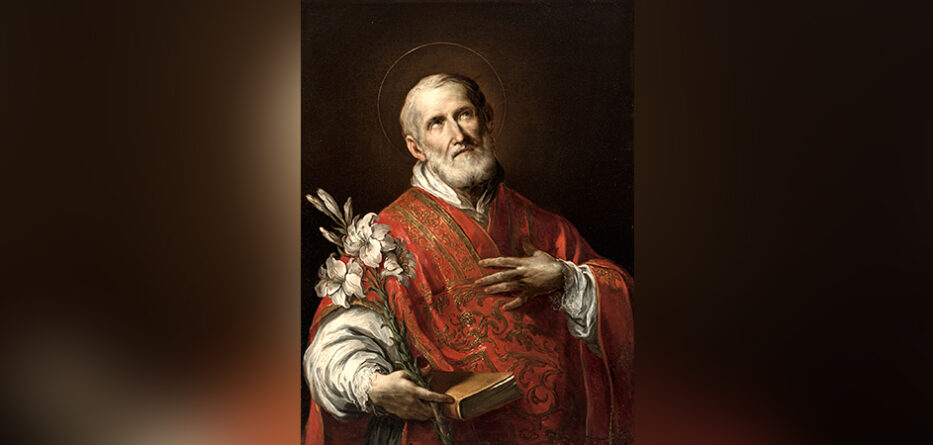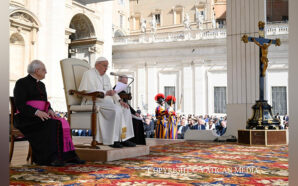A saint for ordinary people
The very thought of a “saint” intimidates many of us. On the one hand, we intensely admire a St. Francis or St. Thérèse of Lisieux. On the other, we are awestruck, humbled, and perhaps a little unnerved by such supernatural virtue. For most of us live more ordinary lives and tend to identify with the virtues that seem within reach, what we can see as our best selves projected before us. We may recoil, however reverently, at a degree of spiritual development that we cannot—or is it will not? —make our own.
Enter St. Philip Neri, a sixteenth-century man whose feast day this month—May 26—should remind us that he was a pillar of the Counter-Reformation Church and yet also a saint for all seasons. The recent quadricentennial of his canonization—four hundred years ago last spring—signifies not his remoteness from us, but rather his remarkable nearness. For a saint, Philip was remarkably ordinary. One might even say he was extraordinary in his ordinariness. He should therefore both inspire and console us. He was not a brilliant thinker, not a spellbinding homilist, not a visionary seer, not a missionary bestriding the globe. He was instead something equally if not more valuable: a divinely blessed listener and a pilgrim of Eucharistic joy. This combination made him an outstanding and indefatigable confessor who regularly devoted hours each day—sometimes as many as sixteen!—to hearing confessions. He heard them even on his sickbed.
But what St. Philip of Neri was even better known for was his mirth, his high jinks and infectious laughter. As the adage has it: he seemed to have wings because he took himself so lightly. Nothing got him down. Endlessly grateful for the blessings of Providence, he was constantly chuckling. His example, following in the tradition of holy fools of earlier centuries, helped serve to modify and even upend the old notion that Christians shouldn’t laugh, which had even been codified as a requirement for humility (precept number 10) in The Rule of St. Benedict.
Because of his capacity to listen and his gift for friendship, people found Philip utterly lovable: a master who cultivated boundless sympathy and yet somehow maintained firm detachment and objectivity toward his friends. His power to direct and edify people through ordinary conversation led his follower Cardinal Agostino Valerio to dub him “the Christian Socrates.”
This is why St. Philip Neri strikes me as such a good model for us today. Can’t we all become better listeners? Can’t we all practice the art of friendship? Can’t we all inspire others to become their best selves? These are all realistic goals for ordinary people. No stigmata required. Finally, can’t we also become more attuned to the call to “live the Eucharist”—a Greek word (eucharistia) that means “thanksgiving”? Gratitude, too, is an ordinary, unintimidating virtue.
Born in 1515 to a family of modest means in Florence, Philip Neri was apprenticed at the age of sixteen to an uncle who was a wealthy tradesman. But Philip was soon disillusioned with commerce and believed he might have a religious vocation, so at eighteen he ventured to Rome and enrolled in a seminary. After three years there, he gave up on ordination, though not on his vocation. He spent the next thirteen years in a lay apostolate—very unusual for that era. He became a kind of street preacher and itinerant hermit who “preached” by simply talking to people one on one. He would talk with anybody; more often, he just listened. “Well, my brother,” he would interject, “when and where shall we begin to do good?” The answer was always the same: here and now. St. John Henry Newman, the great nineteenth-century convert who founded the first Oratory in England, called this mode of witness “the apostolate of personal influence.” St. Ignatius of Loyola, who knew young Philip personally, called him simply “The Bell”—that is, a soul whose upraised voice inspires others to ring out with joy.
At thirty-four, Philip—still a layman—co-founded the Confraternity of Pilgrims and Convalescents, a mixed lay and clerical fraternity. Its members attended Mass together and provided hospitality for pilgrims. In the jubilee year 1550, his small circle often served meals for five hundred people a day. This work with his brothers, and for his brothers and sisters, deepened Philip’s faith; his confessor persuaded him to accept ordination. As a parish priest, Philip soon began to attract far more people than ever before.
There were days when he would hear over a hundred confessions—he believed in using the confessional as a form of spiritual direction—and then he would emerge from the confessional only to pray, celebrate Mass, and sing with his fellows. When he retired to his room above the church, people would often follow him, crowding into the small space for discussion. Soon he began to conduct such discussions in a larger space, eventually in the church itself. Someone would make a short presentation—seldom Philip himself—and others would begin to respond. And this is how the famous Congregation of the Oratory was founded, almost by accident.
The Oratory started as an informal prayer, discussion, and choral group of laypeople who were magnetized by the force of Philip’s appealing personality. “Oratorium” means “place of prayer.” “Ora et labora” (pray and work) was the basis of the ancient monastic ideals, as formulated in the Rule of St. Benedict. Philip united these two activities seamlessly, proclaiming that the Oratorian seems to pray and work constantly, and often simultaneously.
Eventually, some of his followers also became priests and they all lived together. This development marked the formal beginning of the Oratory as a religious community that grew to include aristocrats and cardinals. There were breaks for walks, with members singing as they strolled. One thing led to another, so that the practice of stretching one’s legs between discussion sessions evolved into full-scale, all-day pilgrimages to each of Rome’s seven basilicas. The crowd traveled on foot and stopped for picnics and concerts. They were often accompanied by troubadours and bands. The “house choirmasters” were Palestrina and Giovanni Animuccia, the distinguished Roman composers. The pilgrims ranged from tradesman to aristocrats and bishops—and, on at least one occasion, Michelangelo.
The key to Philip’s personal appeal was his humor. As a boy, his favorite reading had been a famous joke book by a fellow Florentine, Arlotto Mainardi. As a man, Philip was quite a jester—and very jolly as well as a little zany. Writing about Philip in his Italian Journey, Goethe dubbed him “the humorous saint.”
But it wasn’t just that Philip liked a good joke. He radiated joy, a kind of elevated bonhomie. In Mystic in Motley: The Life of Saint Philip Neri, Theodore Maynard reports that Philip would burst suddenly into song at Mass. Fearing he might swoon at the altar with ecstatic fervor, he would direct his altar boys to read aloud his favorite jokes from Mainardi’s book, to bring him back down to earth so that he could concentrate on the ritual tasks at hand. But even this wasn’t always enough to calm him for long. We are told that, as he read the Passion during Holy Week, Philip would play with his keys and spin a sundial placed near the altar in order to help him keep his composure.
On non-liturgical occasions, however, Phillip gave full vent to his holy foolery. For instance, immediately before a visit to a lady of high birth, Philip shaved his long beard—but on one side only. On another occasion, holding an audience with several priests and bishops whom he regarded as excessively strict and morose, he made a parlor guessing game out of forecasting the upcoming papal elections (during the Inquisition, no less!). Philip would sometimes wear his clothes inside-out or dress like a clown, in bright and mismatched shirts and trousers, topped off by a large blue cushion as his hat. (Hence the “Mystic in Motley” of Theodore Maynard’s title.) Or he would carry a broom around, and regularly stop to sniff it and rhapsodize about its aroma. At one Mass, he deliberately mispronounced some Latin words because he had been criticized severely for his alleged ignorance by a fellow prelate. Philip made sure to botch the Latin when the offending prelate was in attendance and planning to report to higher-ups about Philip’s masses.
Philip’s stunts and shenanigans were well known—as were his robust expressions of physical affection. He would box people on the ears, hug them dearly, then do a jig. Some historians have interpreted these actions as the “crazy love” of the fool for Christ, who seeks to be brought lower in the world’s eyes as a way of keeping his ego in check.
Unsurprisingly, such unorthodox behaviors—not to mention the extravaganza of the Oratory on pilgrimage—finally brought Philip to the attention of the Inquisition. The Oratory and Philip were accused by some clerical bluenoses of being an assembly of heretics and profligates. For a few years in the late 1550s, under Pope Paul V, the Oratorians’ pilgrimages were forbidden and other restrictions were set in place. “I am an obedient servant,” Philip remarked on hearing the pope’s decision, and he did not put up a fight. Nonetheless, he eventually prevailed: by the mid-1560s, the activities of the Oratory had resumed, and it soon flourished on a scale greater than ever.
Goethe identified so strongly with Philip that he travelled throughout Italy during his twenties under the alias “Filippo Miller, pittore tedesco” (Philip Miller, German painter). No admirer of the Catholic Church, Goethe made an exception of “my patron saint.” Goethe’s two essays on Philip introduced him to the German-speaking public and established his fame in non-Catholic Europe as “the merriest man alive,” the “saint of Holy Wit.” Or as Theodore Maynard put it: “He was an incomprehensible saint, an impossible saint, and yet the most human of humans.” Philip embodied “an exquisite blending of Grace and nature,” writes Father Joseph Hussle, SJ. “Few men have ever been so deeply loved.”
Phyllis McGinley gives voice to that perception in her endearing and witty poem, “Goethe and Saint Philip Neri”:
Knight, novice, scholar, boisterous boy,
They followed after him with joy
To nurse his poor and break his bread
And hear the funny things he said.
For Philip Neri (by his birth
A Florentine) believed in mirth,
Holding that virtues took no harm
Which went with laughter arm in arm.
Two books he read with most affection—
The Gospels and a joke collection;
And sang hosannas set to fiddles
And fed the sick on soup and riddles.
So when the grave rebuke the merry,
Let them remember Philip Neri.
We need saints like Philip Neri—examples of lightness of spirit, divine laughter, and daily eucharistic joy. We need saints who, whatever their eccentricities, appeal to ordinary people. The “Bell” rings out to us across the centuries, not only on his feast day, not only on holy days, but on all the days of ordinary time when our faith must be lived out not in heroic displays of virtue or devotion, but with small, modest acts of joyful charity.
John Rodden recently wrote for Commonweal about St. Michael the Archangel and about the history of Penance as a sacrament.
Reproduced with permission from Commonweal.








